Optimization of Transmission X-ray Target for Intense Pulsed Electron Beam Accelerators
Abstract
:Featured Application
Abstract
1. Introduction
2. Materials and Methods
2.1. IPEB Energy Spectrum Analysis
2.2. X-ray Conversion Simulation
3. Results and Discussion
4. Conclusions
Supplementary Materials
Author Contributions
Funding
Institutional Review Board Statement
Informed Consent Statement
Acknowledgments
Conflicts of Interest
References
- Röntgen, W.C. On a new kind of rays. Science 1896, 3, 227–231. [Google Scholar] [CrossRef] [PubMed]
- Behling, R. Medical X-ray sources now and for the future. Nucl. Instrum. Methods Phys. Res. Sect. A Accel. Spectrometers Detect. Assoc. Equip. 2017, 873, 43–50. [Google Scholar] [CrossRef]
- Behling, R. Modern Diagnostic X-Ray Sources: Technology, Manufacturing, Reliability; CRC Press: Boca Raton, FL, USA, 2015; ISBN 9781482241334. [Google Scholar]
- Hanawalt, J.D.; Rinn, H.W.; Frevel, L.K. Chemical Analysis by X-ray Diffraction. Ind. Eng. Chem. Anal. Ed. 1938, 10, 457–512. [Google Scholar] [CrossRef]
- Baruchel, J.; Buffière, J.Y.; Maire, E.; Merle, P.; Peix, G. X-ray tomography in material science. Hermes Sci. Publ. 2000, 31, 1–209. [Google Scholar]
- Hanke, R.; Fuchs, T.; Uhlmann, N. X-ray based methods for non-destructive testing and material characterization. Nucl. Instrum. Methods Phys. Res. Sect. A Accel. Spectrometers Detect. Assoc. Equip. 2008, 591, 14–18. [Google Scholar] [CrossRef]
- Jenkins, R. X-ray Techniques: Overview. In Encyclopedia of Analytical Chemistry: Applications, Theory and Instrumentation; John Wiley & Sons, Ltd.: Hoboken, NJ, USA, 2006; ISBN 9780471976707. [Google Scholar] [CrossRef]
- Zentai, G. X-ray imaging for homeland security. Int. J. Signal Imaging Syst. Eng. 2010, 3, 13–20. [Google Scholar] [CrossRef]
- Chakhlov, S.V.; Kasyanov, S.V.; Kasyanov, V.A.; Osipov, S.P.; Stein, M.M.; Stein, A.M.; Xiaoming, S. Betatron application in mobile and relocatable inspection systems for freight transport control. J. Physics Conf. Ser. 2016, 671, 12024. [Google Scholar] [CrossRef] [Green Version]
- Tang, C.; Chen, H.; Liu, Y.; Wang, X. Low-energy linacs and their applications in tsinghua university. In Proceedings of the 23rd International Linear Accelerator Conference, LINAC 2006, Knoxville, TN, USA, 21–25 August 2006; pp. 256–258. [Google Scholar]
- Bartscher, M.; Hilpert, U.; Goebbels, J.; Weidemann, G. Enhancement and Proof of Accuracy of Industrial Computed Tomography (CT) Measurements. CIRP Ann. Manuf. Technol. 2007, 56, 495–498. [Google Scholar] [CrossRef]
- du Plessis, A.; le Roux, S.G.; Guelpa, A. Comparison of medical and industrial X-ray computed tomography for non-destructive testing. Case Stud. Nondestruct. Test. Eval. 2016, 6, 17–25. [Google Scholar] [CrossRef] [Green Version]
- Edwards, D.A.; Syphers, M.J. An introduction to the physics of particle accelerators. AIP Conf. Proc. 2008, 184, 2–189. [Google Scholar] [CrossRef]
- Tajima, T.; Dawson, J.M. Laser electron accelerator. Phys. Rev. Lett. 1979, 43, 267–270. [Google Scholar] [CrossRef] [Green Version]
- Faure, J.; Glinec, Y.; Pukhov, A.; Klselev, S.; Gordienko, S.; Lefebvre, E.; Rousseau, J.P.; Burgy, F.; Malka, V. A laser-plasma accelerator producing monoenergetic electron beams. Nature 2004, 431, 541–544. [Google Scholar] [CrossRef] [PubMed]
- Egorov, I.S.; Kaikanov, M.I.; Lukonin, E.I.; Remnev, G.E.; Stepanov, A.V. The Astra repetitive-pulse electron accelerator. Instrum. Exp. Technol. 2013, 56, 568–570. [Google Scholar] [CrossRef]
- Nashilevskiy, A.; Egorov, I.; Ponomarev, D.; Ezhov, V.; Kholodnaya, G.; Remnev, G. A high repetition rate electron accelerator with a water Blumlein and a matching transformer. Nucl. Instrum. Methods Phys. Res. Sect. A Accel. Spectrometers Detect. Assoc. Equip. 2020, 959, 163565. [Google Scholar] [CrossRef]
- Sazonov, R.; Kholodnaya, G.; Ponomarev, D.; Lapteva, O.; Konusov, F.; Gadirov, R.; Zhirkov, I. Pulsed plasma chemical synthesis of TiO2@TixCyOz nanocomposite. Fullerenes Nanotub. Carbon Nanostruct. 2021, 29, 567–575. [Google Scholar] [CrossRef]
- Siwek, M.; Edgecock, T. Application of electron beam water radiolysis for sewage sludge treatment—A review. Environ. Sci. Pollut. Res. 2020, 27, 42424–42448. [Google Scholar] [CrossRef]
- Kholodnaya, G.; Egorov, I.; Sazonov, R.; Serebrennikov, M.; Poloskov, A.; Ponomarev, D.; Zhirkov, I. Study of the conditions for the effective initiation of plasma-chemical treatment of flue gas under the influence of a pulsed electron beam. Laser Part. Beams 2020, 38, 197–203. [Google Scholar] [CrossRef]
- Isemberlinova, A.A.; Egorov, I.S.; Nuzhnyh, S.A.; Poloskov, A.V.; Pokrovskaya, E.A.; Vertinskiy, A.V.; Konusov, F.V.; Sukhikh, E.S.; Chubik, M.V.; Remnev, G.E. The pulsed X-ray treatment of wheat against pathogenic fungi. Nucl. Instrum. Methods Phys. Res. Sect. B Beam Interact. Mater. Atoms 2021, 503, 75–78. [Google Scholar] [CrossRef]
- Kudryavtseva, V.L.; Bolbasov, E.N.; Ponomarev, D.V.; Remnev, G.E.; Tverdokhlebov, S.I. The Influence of Pulsed Electron Beam Treatment on Properties of PLLA Nonwoven Materials Produced by Solution Blow Spinning. Bionanoscience 2018, 8, 131–139. [Google Scholar] [CrossRef]
- Egorov, I.; Yu, X.; Poloskov, A.; Serebrennikov, M.; Le, X.; Remnev, G. Bremsstrahlung converter system with target in vacuum. Vacuum 2021, 187, 110149. [Google Scholar] [CrossRef]
- Egorov, I.; Poloskov, A.; Serebrennikov, M.; Remnev, G. Self-bearing membrane exit window with the separate anode for sub-microsecond electron accelerator: Exit window for sub-microsecond e-accelerator. Vacuum 2020, 173, 109111. [Google Scholar] [CrossRef]
- Yu, X.; Shen, J.; Zhang, S.; Zhang, J.; Zhang, N.; Egorov, I.S.; Yan, S.; Tan, C.; Remnev, G.E.; Le, X. Numerical optimization of transmission bremsstrahlung target for intense pulsed electron beam. Nucl. Eng. Technol. 2022, 54, 666–673. [Google Scholar] [CrossRef]
- Yu, X.; Shen, J.; Qu, M.; Liu, W.; Zhong, H.; Zhang, J.; Yan, S.; Zhang, G.; Le, X. Infrared imaging diagnostics for intense pulsed electron beam. Rev. Sci. Instrum. 2015, 86, 83305. [Google Scholar] [CrossRef] [PubMed]
- Langmuir, I. The effect of space charge and residual gases on thermionic currents in high vacuum. Phys. Rev. 1913, 2, 450–486. [Google Scholar] [CrossRef]
- Böhlen, T.T.; Cerutti, F.; Chin, M.P.W.; Fassò, A.; Ferrari, A.; Ortega, P.G.; Mairani, A.; Sala, P.R.; Smirnov, G.; Vlachoudis, V. The FLUKA Code: Developments and challenges for high energy and medical applications. Nucl. Data Sheets 2014, 120, 211–214. [Google Scholar] [CrossRef] [Green Version]
- Battistoni, G.; Boehlen, T.; Cerutti, F.; Chin, P.W.; Esposito, L.S.; Fassò, A.; Ferrari, A.; Lechner, A.; Empl, A.; Mairani, A.; et al. Overview of the FLUKA code. Ann. Nucl. Energy 2015, 82, 10–18. [Google Scholar] [CrossRef] [Green Version]
- Lakshminarayana, G.; Kumar, A.; Tekin, H.O.; Issa, S.A.M.; Al-Buriahi, M.S.; Dong, M.G.; Lee, D.E.; Yoon, J.; Park, T. In-depth survey of nuclear radiation attenuation efficacies for high density bismuth lead borate glass system. Results Phys. 2021, 23, 104030. [Google Scholar] [CrossRef]
- Mostafa, A.M.A.; Issa, S.A.M.; Zakaly, H.M.H.; Zaid, M.H.M.; Tekin, H.O.; Matori, K.A.; Sidek, H.A.A.; Elsaman, R. The influence of heavy elements on the ionizing radiation shielding efficiency and elastic properties of some tellurite glasses: Theoretical investigation. Results Phys. 2020, 19, 103496. [Google Scholar] [CrossRef]
- El-Denglawey, A.; Zakaly, H.M.H.; Alshammari, K.; Issa, S.A.M.; Tekin, H.O.; AbuShanab, W.S.; Saddeek, Y.B. Prediction of mechanical and radiation parameters of glasses with high Bi2O3 concentration. Results Phys. 2021, 21, 103839. [Google Scholar] [CrossRef]
- Botta, F.; Mairani, A.; Battistoni, G.; Cremonesi, M.; Di Dia, A.; Fassò, A.; Ferrari, A.; Ferrari, M.; Paganelli, G.; Pedroli, G.; et al. Calculation of electron and isotopes dose point kernels with fluka Monte Carlo code for dosimetry in nuclear medicine therapy. Med. Phys. 2011, 38, 3944–3954. [Google Scholar] [CrossRef]
- Kirby, D.; Green, S.; Fiorini, F.; Parker, D.; Romagnani, L.; Doria, D.; Kar, S.; Lewis, C.; Borghesi, M.; Palmans, H. Radiochromic film spectroscopy of laser-accelerated proton beams using the FLUKA code and dosimetry traceable to primary standards. Laser Part. Beams 2011, 29, 231–239. [Google Scholar] [CrossRef]
- Guthoff, M.; De Boer, W.; Müller, S. Simulation of beam induced lattice defects of diamond detectors using FLUKA. Nucl. Instrum. Methods Phys. Res. Sect. A Accel. Spectrometers Detect. Assoc. Equip. 2014, 735, 223–228. [Google Scholar] [CrossRef]
- Fassò, A.; Ferrari, A.; Ranft, J.; Sala, P.R.; Stevenson, G.R.; Zazula, J.M. A comparison of FLUKA simulations with measurements of fluence and dose in calorimeter structures. Nucl. Inst. Methods Phys. Res. A 1993, 332, 459–468. [Google Scholar] [CrossRef] [Green Version]
- Akkurt, İ.; Waheed, F.; Akyildirim, H.; Gunoglu, K. Monte Carlo simulation of a NaI(Tl) detector efficiency. Radiat. Phys. Chem. 2020, 176, 109081. [Google Scholar] [CrossRef]
- Liu, J.; Han, L.; Zhao, W.; Ma, Y.; Niu, G. Design and fabrication of a new tungsten-diamond transmission target for micro-computed tomography. In Proceedings of the 9th International Symposium on Advanced Optical Manufacturing and Testing Technologies: Micro-and Nano-Optics, Catenary Optics, and Subwavelength Electromagnetics, Chengdu, China, 26–29 June 2018; International Society for Optics and Photonics: Bellingham, WA, USA, 2019. [Google Scholar]
- Wang, S.F.; Chiang, H.Y.; Liao, Y.J.; Liu, R.S.; Cheng, C.C.; Yang, H.W.; Wang, S.W.; Lin, Y.C.; Hsu, S.M. Respective radiation output characteristics of transmission-target and reflection-target X-ray tubes with the same beam quality. Radiat. Phys. Chem. 2019, 158, 188–193. [Google Scholar] [CrossRef]
- Nasseri, M.M. Determination of Tungsten Target Parameters for Transmission X-ray Tube: A Simulation Study Using Geant4. Nucl. Eng. Technol. 2016, 48, 795–798. [Google Scholar] [CrossRef] [Green Version]
- Battistoni, G.; Bauer, J.; Boehlen, T.T.; Cerutti, F.; Chin, M.P.W.; Dos Santos Augusto, R.; Ferrari, A.; Ortega, P.G.; Kozlowska, W.; Magro, G.; et al. The FLUKA code: An accurate simulation tool for particle therapy. Front. Oncol. 2016, 6, 116. [Google Scholar] [CrossRef] [Green Version]
- Vlachoudis, V. Flair: A powerful but user friendly graphical interface for FLUKA. In Proceedings of the International Conference on Mathematics, Computational Methods and Reactor Physics 2009, Saragota Springs, NY, USA, 3–7 May 2009; American Nuclear Society: La Grange Park, IL, USA, 2009; Volume 2, pp. 790–800. [Google Scholar]
- Berger, M.J.; Coursey, J.S.; Zucker, M.A.; Chang, J. Stopping-Power & Range Tables for Electrons, Protons, and Helium Ions. NISTIR 2017, 4999, 1–17. [Google Scholar] [CrossRef]
- ICRP International Commission on Radiological Protection. Conversion coefficients for use in radiological protection against external radiation. Ann. ICRP 1996, 26, 1–205. [Google Scholar]
- Pelliccioni, M. Overview of fluence-to-effective dose and fluence-to-ambient dose equivalent conversion coefficients for high energy radiation calculated using the fluka code. Radiat. Prot. Dosim. 2000, 88, 279–297. [Google Scholar] [CrossRef]
- Egorov, I.; Xiao, Y.; Poloskov, A. PIN-diode diagnostics of pulsed electron beam for high repetition rate mode. J. Phys. Conf. Ser. 2017, 830, 12044. [Google Scholar] [CrossRef] [Green Version]
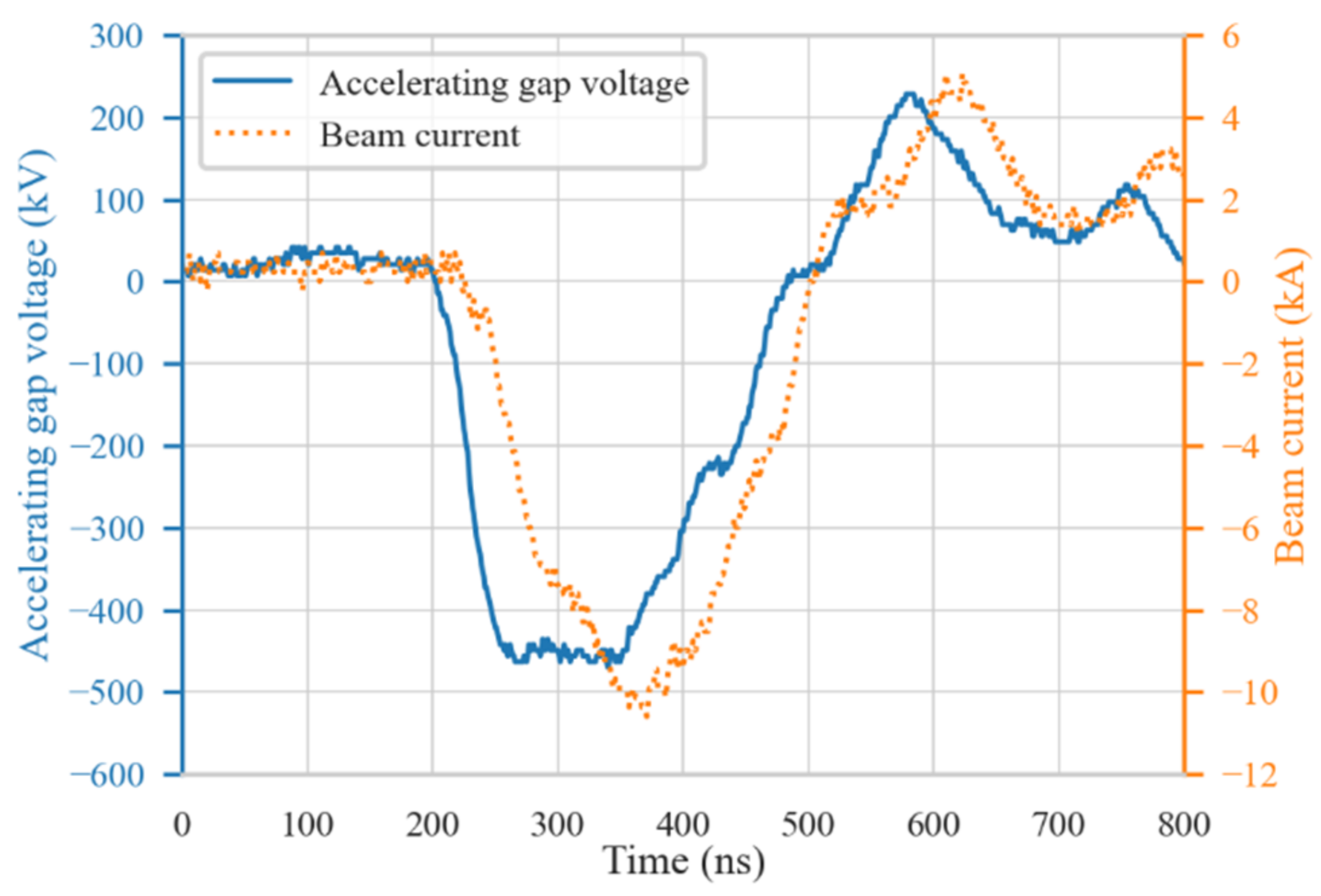
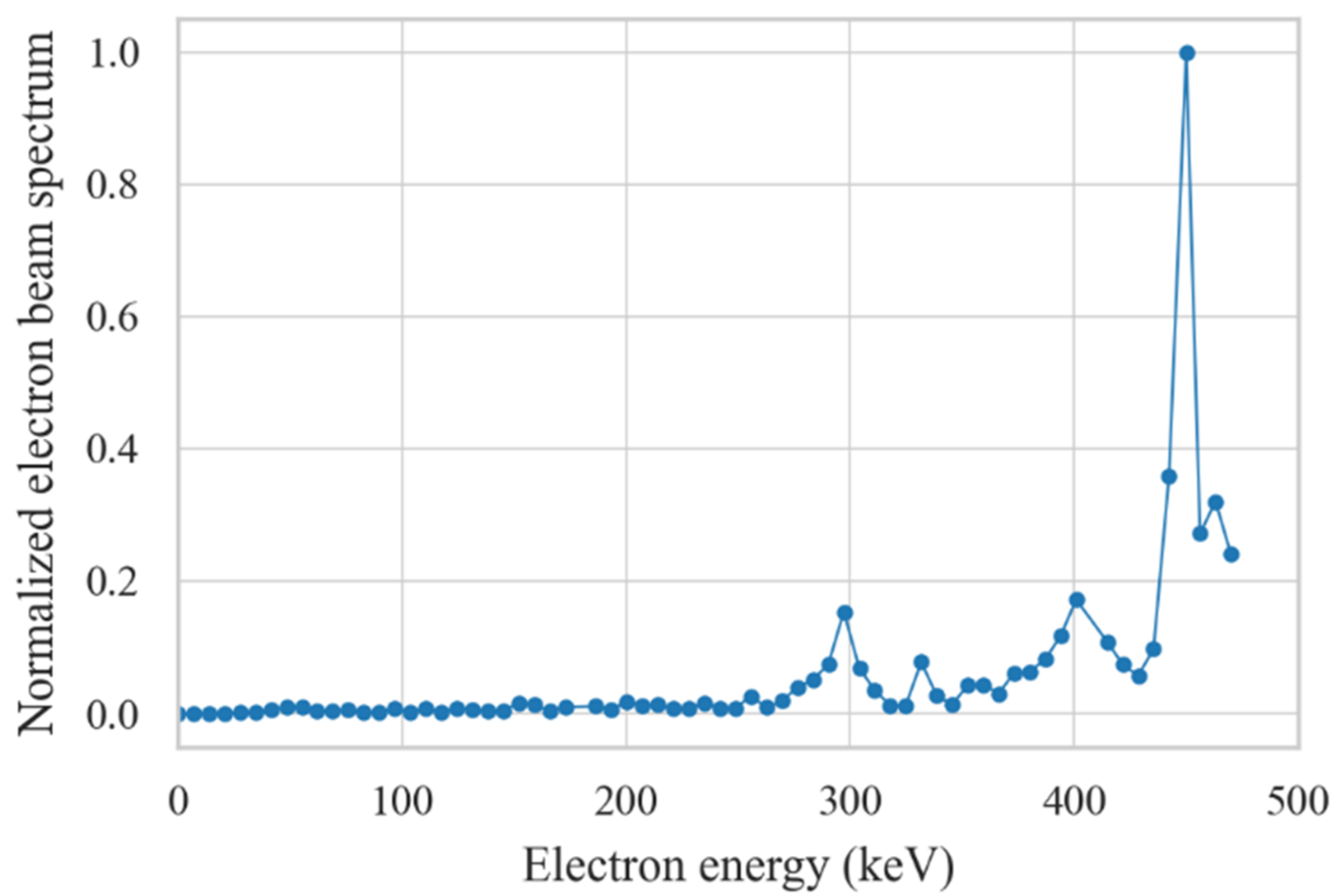
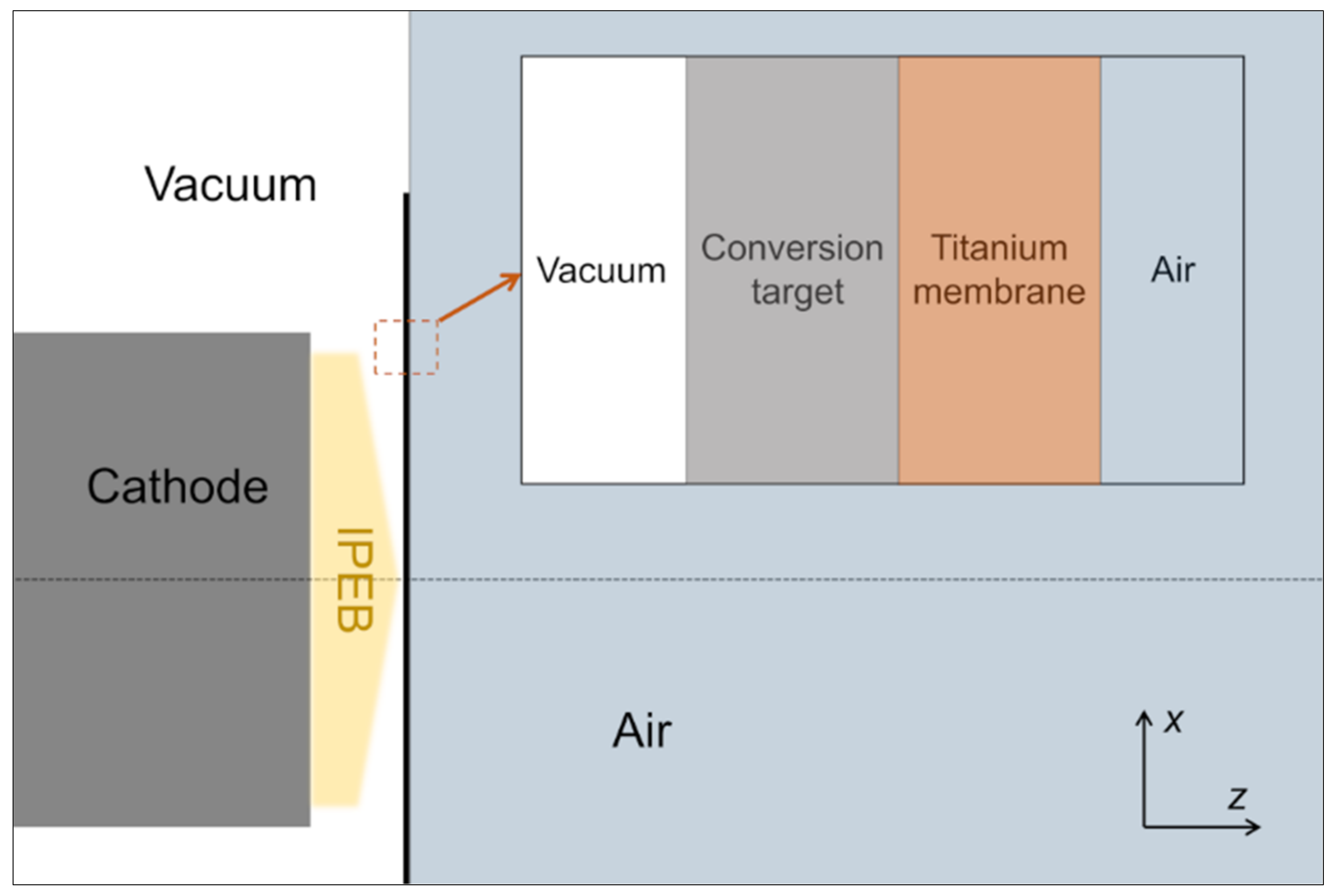
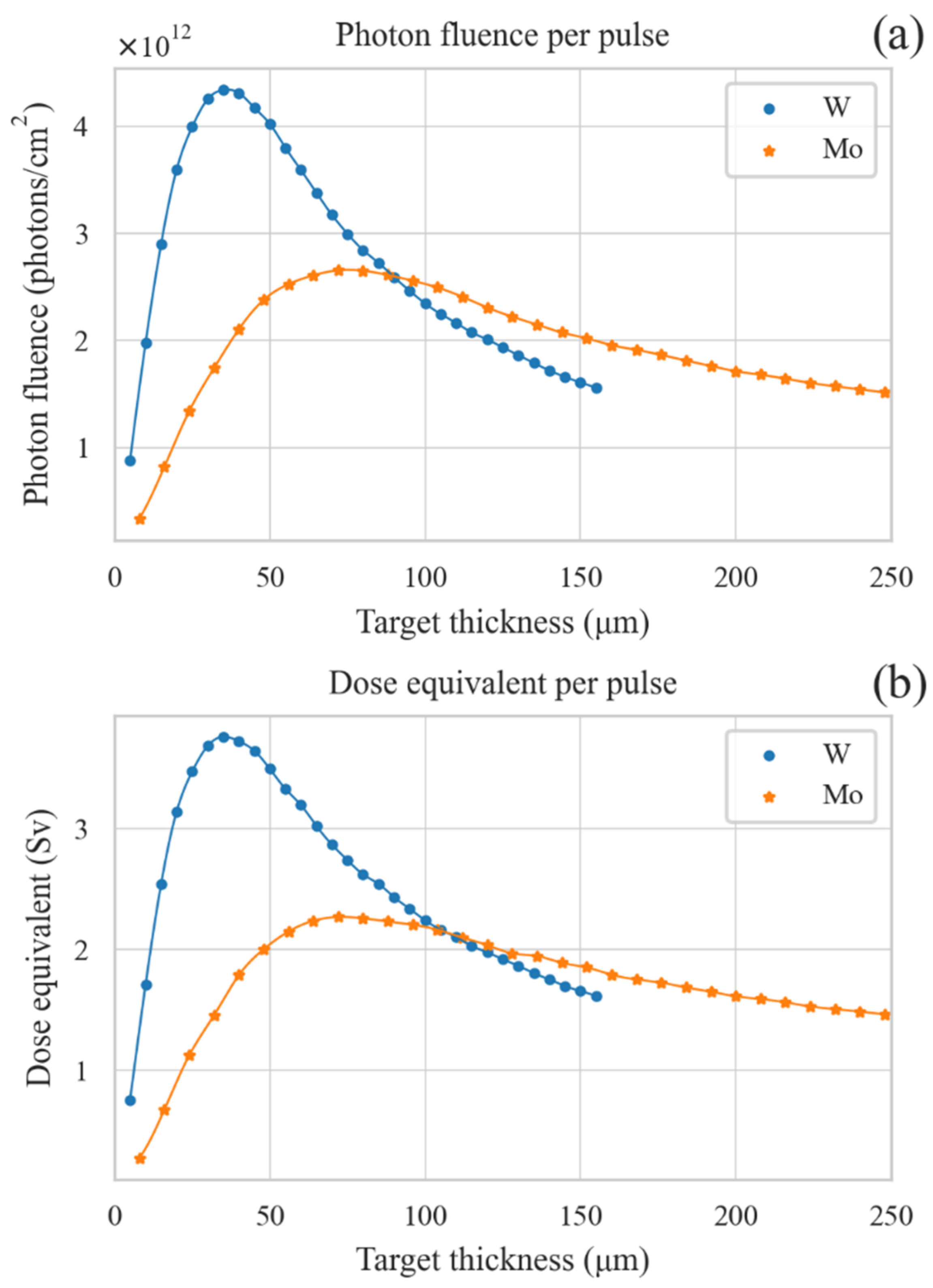

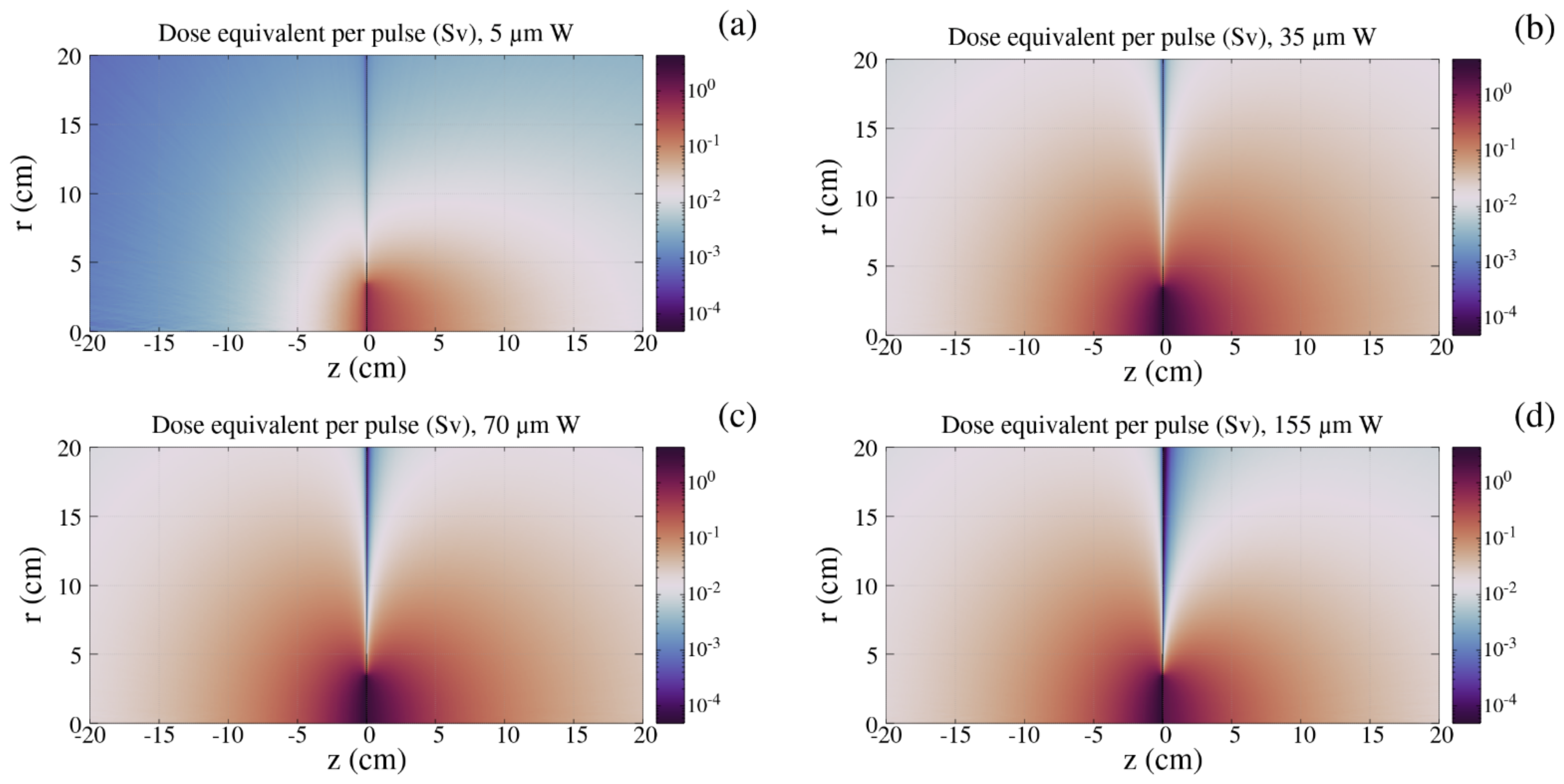

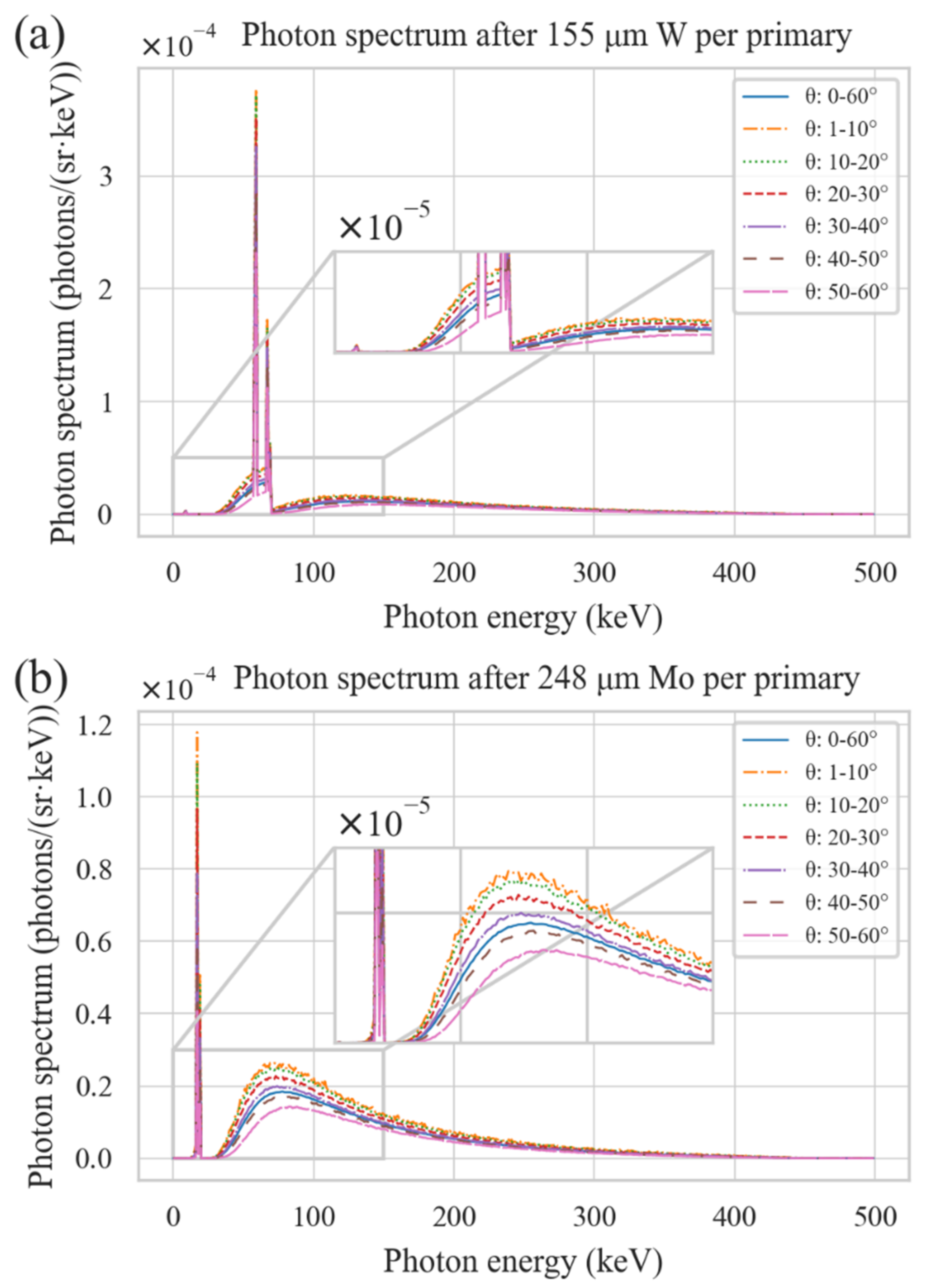


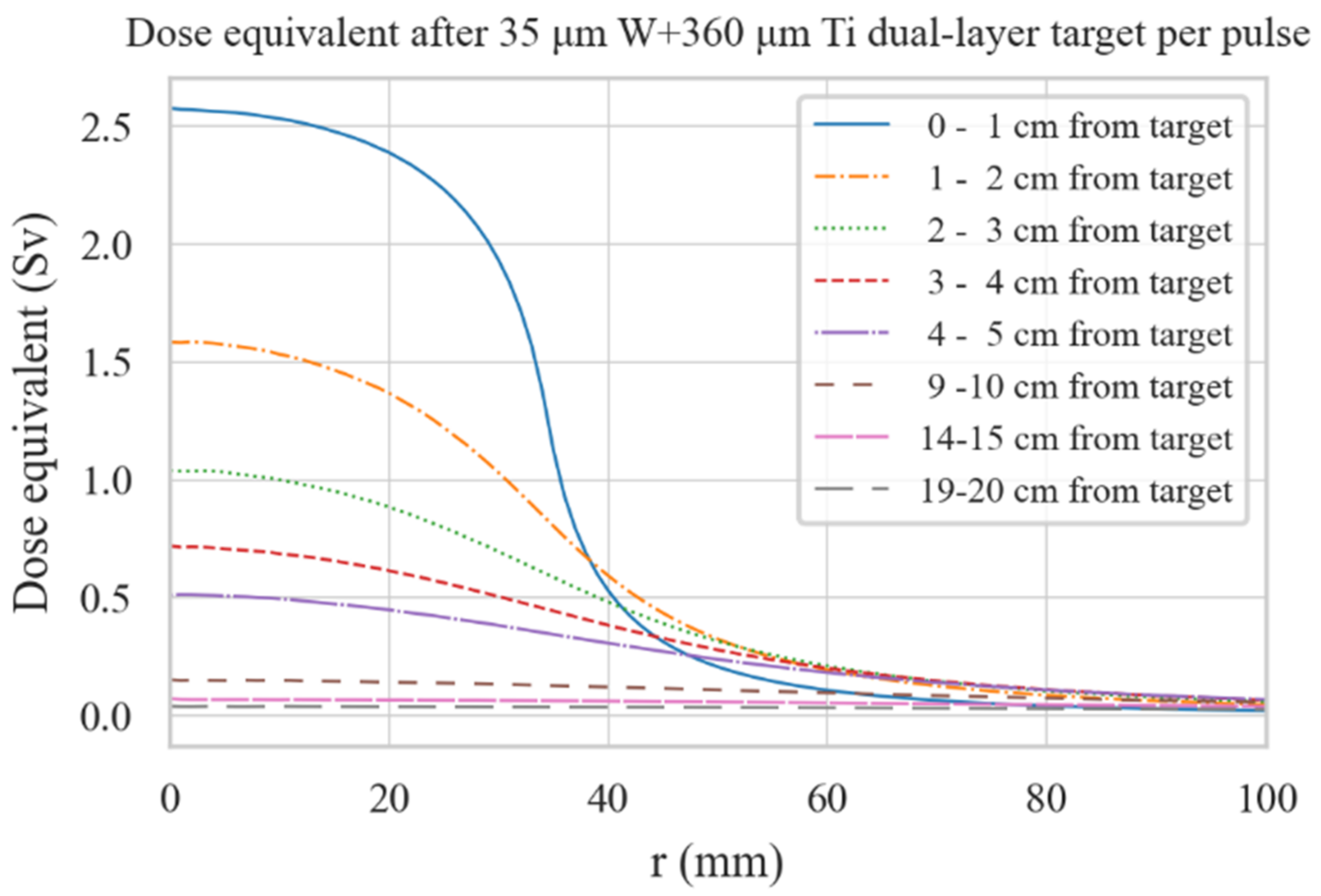

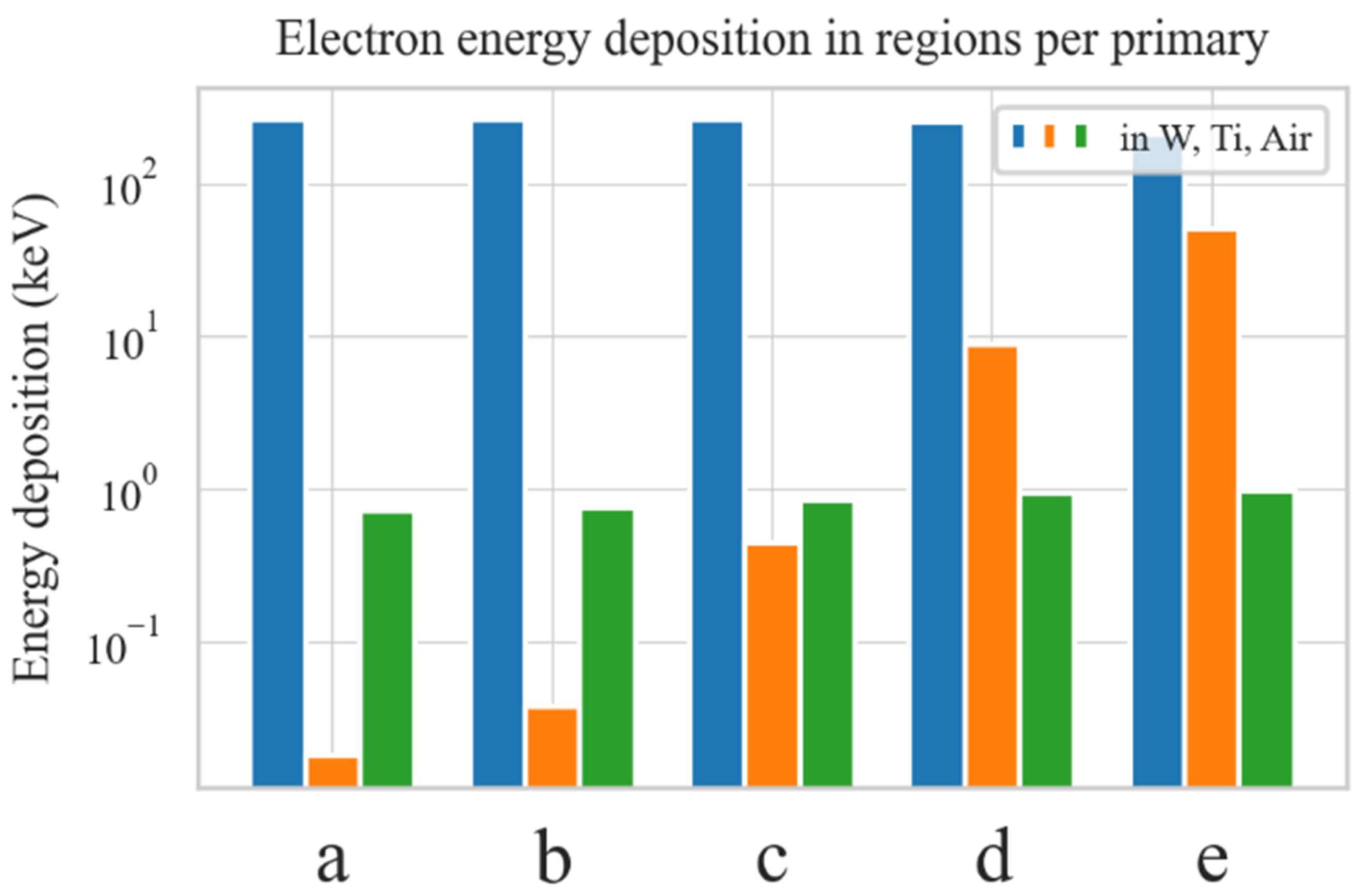
| a | b | c | d | e | |
|---|---|---|---|---|---|
| W | 115 | 105 | 80 | 55 | 35 |
| Ti | 50 | 100 | 200 | 300 | 360 |
| a | b | c | d | e | |
|---|---|---|---|---|---|
| Mo | 205 | 180 | 137 | 90 | 72 |
| Ti | 50 | 100 | 200 | 300 | 340 |
| a | b | c | d | e | |
|---|---|---|---|---|---|
| W + Ti | 2.023 | 2.170 | 2.663 | 3.298 | 3.727 |
| Mo + Ti | 1.653 | 1.741 | 1.957 | 2.259 | 2.367 |
Publisher’s Note: MDPI stays neutral with regard to jurisdictional claims in published maps and institutional affiliations. |
© 2022 by the authors. Licensee MDPI, Basel, Switzerland. This article is an open access article distributed under the terms and conditions of the Creative Commons Attribution (CC BY) license (https://creativecommons.org/licenses/by/4.0/).
Share and Cite
Yu, X.; Zhang, S.; Egorov, I.S.; Zhao, J.; Xiong, C.; Yan, S.; Tan, C.; Remnev, G.E.; Le, X. Optimization of Transmission X-ray Target for Intense Pulsed Electron Beam Accelerators. Appl. Sci. 2022, 12, 4327. https://doi.org/10.3390/app12094327
Yu X, Zhang S, Egorov IS, Zhao J, Xiong C, Yan S, Tan C, Remnev GE, Le X. Optimization of Transmission X-ray Target for Intense Pulsed Electron Beam Accelerators. Applied Sciences. 2022; 12(9):4327. https://doi.org/10.3390/app12094327
Chicago/Turabian StyleYu, Xiao, Shijian Zhang, Ivan Sergeevich Egorov, Jiangqi Zhao, Chang Xiong, Sha Yan, Chang Tan, Gennady Efimovich Remnev, and Xiaoyun Le. 2022. "Optimization of Transmission X-ray Target for Intense Pulsed Electron Beam Accelerators" Applied Sciences 12, no. 9: 4327. https://doi.org/10.3390/app12094327
APA StyleYu, X., Zhang, S., Egorov, I. S., Zhao, J., Xiong, C., Yan, S., Tan, C., Remnev, G. E., & Le, X. (2022). Optimization of Transmission X-ray Target for Intense Pulsed Electron Beam Accelerators. Applied Sciences, 12(9), 4327. https://doi.org/10.3390/app12094327





